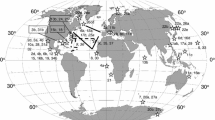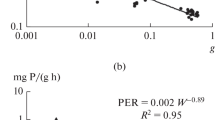Abstract
During July of 1983, 1986, and 1987, we measured rates of oxygen consumption of 234 individuals of 17 species of midwater crustaceans (orders Decapoda, Mysidacea, and Euphausiacea) off the Hawaiian islands at depths from the surface to greater than 1200 m. The routine metabolic rates declined with increasing depths of the species' occurrence to an extent greater than could be accounted for by depth-related changes in body size or water temperature. Most species appeared able to regulate their oxygen consumption down to the lowest oxygen partial pressures found in their depth range (20 mm Hg O2), but did not regulate to such low oxygen partial pressures as did similar midwater crustaceans off California, where oxygen levels reach as low as 6 mm Hg. Metabolic rates of the shallower-living, but not the deepest-living Hawaiian crustaceans were significantly higher than those of Californian crustaceans. This is interpreted as indicating that the metabolic rates of midwater crustaceans are not adapted specifically to differing levels of primary production and that the decline with depth of metabolic rates in these species is not the result of food limitation at depth. The data are, however, consistent with the hypothesis that lower metabolic rates at depth are due to the relaxation of selection pressures relating to visual predation near the surface.
Similar content being viewed by others
Literature cited
Bailey, T. G., Robison, B. H. (1986). Food availability as a selective factor on the chemical composition of midwater fishes in the eastern North Pacific. Mar. Biol. 91: 131–141
Boden, B. P. (1961). Twilight irradiance in the sea. In: Jerlov, N. G. (ed.) Symposium on radiant energy in the sea. International Association of Physical Oceanography, Paris, p. 96–101
Chace, F. A. (1986). The caridean shrimps (Crustacea: Decapoda) of the Albatross Philippine expedition, 1907–1910, Part4: families Oplophoridae and Nematocarcinidae. Smithson. Contr. Zool. 432: 1–82
Childress, J. J. (1968). Oxygen minimum layer: vertical distribution and respiration of the mysidGnathophausia ingens. Science, N.Y. 160: 1242–1243
Childress, J. J. (1969a). The respiratory physiology of the oxygen minimum layer mysidGnathophausia ingens. Ph. D. thesis. Stanford University, California.
Childress, J. J. (1969b). The respiration of deep-sea crustaceans as related to their depth of occurrence and the oxygen minimum layer. Am. Zool. 9: p. 222
Childress, J. J. (1971). Respiratory adaptations to the oxygen minimum layer in the bathypelagic mysidGnathophausia ingens. Biol. Bull. mar. biol. Lab., Woods Hole 141: 1 109–121
Childress, J. J. (1975). The respiratory rates of midwater crustaceans as a function of depth of occurrence and relation to the oxygen minimum layer off southern California. Comp. Biochem. Physiol. 50A: 787–799
Childress, J. J. (1977). Physiological approaches to the biology of midwater organisms. In: Andersen, N. R., Zahuranec, B. J. (eds.) Oceanic sound scattering prediction. Plenum Press, New York, p. 301–324
Childress, J. J., Barnes, A. T., Quetin, L. B., Robison, B. H. (1978). Thermally protecting cod ends for the recovery of living deepsea animals. Deep-Sea Res. 25: 419–422
Childress, J. J., Cowles, D. L., Favuzzi, J. A., Mickel, T. J. (1990a). Metabolic rates of deep-sea decapod crustaceans decline with increasing depth primarily due to the decline in temperature. Deep-Sea Res. 37: 929–949
Childress, J. J., Mickel, T. J. (1985). Metabolic rates of animals from the hydrothermal vents and other deep-sea habitats. Bull. biol. Soc. Wash. 6: 249–260
Childress, J. J., Nygaard, M. H. (1973). The chemical composition of midwater fishes as a function of depth of occurrence off Southern California. Deep-Sea Res. 20: 1093–1109
Childress, J. J., Nygaard, M. (1974). The chemical composition and buoyancy of midwater crustaceans as a function of depth off Southern California. Mar. Biol. 27: 225–238
Childress, J. J., Price, M. H., Favuzzi, J., Cowles, D. L. (1990b). Chemical composition of midwater fishes as a function of depth of occurrence off the Hawaiian Islands: food availability as a selective factor? Mar. Biol. 105: 235–246
Childress, J. J., Somero, G. N. (1979). Depth-related enzymic activities in muscle, brain and heart of deep-living pelagic marine teleosts. Mar. Biol. 52: 273–283
Childress, J. J., Taylor, S. M., Cailliet, G. M., Price, M. H. (1980). Patterns of growth, energy utilization and reproduction in some meso- and bathypelagic fishes off southern California. Mar. Biol. 61: 27–40
Clarke, G. L. (1961). The conditions of light in the sea with special reference to bioluminescence. In: Jerlov, N. G. (ed.) Symposium on radiant energy in the sea. International Association of Physical Oceanography, Paris, p. 101–103
Clarke, G. L. (1971). Light conditions in the sea in relation to the diurnal migrations of animals. In: Farquhar, G. B. (ed.) Proceedings of an international symposium on biological sound scattering in the ocean. Maury Center for Ocean Science, Washington, D.C., p. 41–50
Clarke, G. L., Denton, E. J. (1962). Light and animal life. In: Hill, M. N. (ed.) The sea. Vol. 1. Interscience Publishers, New York, p. 456–468
Clarke, W. G. (1962). The genusGnathophausia (Mysidacea, Crustacea), its systematics and distribution in the Pacific Ocean. Ph. D. dissertation University of California, San Diego
Cowles, D. L. (1987). Factors affecting the aerobic metabolism of midwater crustaceans. Ph. D. dissertation. University of California, Santa Barbara
Cowles, D. L., Childress, J. J. (1988). Swimming speed and oxygen consumption in the bathypelagic mysidGnathophausia ingens. Biol. mar. biol. Lab., Woods Hole 175: 111–121
Cullen, J. J., Eppley, R. W. (1981). Chlorophyll maximum layers of the Southern California Bight and possible mechanisms of their formation and maintenance. Oceanol. Acta 4: 1 23–32
Denton, E. J., Gray, J. A. B. (1988). Mechanical factors in the excitation of the lateral lines of fishes. In: Atema, J., Fay, R. R., Popper, A. N., Tavolga, W. N. (eds.) Sensory biology of aquatic animals. Springer-Verlag, New York, p. 595–617
Donnelly, J., Torres, J. J. (1988). Oxygen consumption of midwater fishes and crustaceans from the eastern Gulf of Mexico. Mar. Biol. 97: 483–494
George, R. Y. (1981). Functional adaptations of deep-sea organisms. In: Vernberg, F. J., Vernberg, W. B. (eds.) Functional adaptations of marine organisms. Academic Press, N.Y., p. 279–332
Gordon, D. C. (1970). Chemical and biological observations at station Gollum, and oceanic station near Hawaii, January 1969 to June 1970. Hawaii University, Institute of Geophysics (Internal Rep. HIG-70-22)
Hayward, T. L., McGowan, J. A. (1985). Spatial patterns of chlorophyll, primary production, macrozooplankton, biomass, and physical structure in the central North Pacific Ocean. J. Plankton Res. 7: 147–167
Hayward, T. L., Venrick, E. L., McGowan, J. A. (1983). Environmental heterogeneity and plankton community structure in the central North Pacific. J. mar. Res. 41: 711–729
Ikeda, T. (1988). Metabolism and chemical composition of crustaceans from the Antarctic mesopelagic zone. Deep-Sea Res. 35: 1991–2002
Loeb, V. J., Smith, P. E., Moser, N. G. (1983). Icthyoplankton and zooplankton abundance patterns in the California Current area, 1975. Rep. Calif. coop. ocean. Fish. Invest. 24: 109–131
Lythgoe, J. N. (1988). Light and vision in the aquatic environment. In: Atema, J., Fay, R. R., Popper, A. N., Tavolga, W. N. (eds.) Sensory biology of aquatic animals. Springer-Verlag, New York, p. 57–82
Marshall, N. B. (1979). Developments in deep-sea biology. Blandford Press, Poole, UK
Mauchline, J. (1972). The biology of bathypelagic organisms, especially Crustacea. Deep-Sea Res. 19: 753–780
Mickel, T. J., Quetin, L. B., Childress, J. J. (1983). Construction of a polarographic oxygen sensor in the laboratory. In: Gnaiger, E., Forstner, H. (eds.) Polarographic oxygen sensors. Springer-Verlag, Berlin, p. 81–85
Murray, C. N., Riley, J. P. (1969). The solubility of gases in distilled water and seawater — II. Oxygen. Deep-Sea Res. 16: 311–320
Nicol, J. A. C. (1978). Bioluminescence and vision. In: Herring, P. J. (ed.) Bioluminescence in action. Academic Press, New York, p. 367–398
Owen, R. W., Jr. (1974). Distribution of primary production, plant pigments, and Secchi depth in the California Current region, 1969. Calif. coop. ocean. Fish. Invest. Atlas 20: 98–117
Raymont, J. E. G. (1980). Plankton and productivity in the oceans. 2nd ed. Vol. 1: Phytoplankton. Pergamon Press, New York
Reid, J. L. (1962). On circulation, phosphate-phosphorus content, and zooplankton volumes in the upper part of the Pacific Ocean. Limnol. Oceanogr. 7: 287–306
Sanders, N. K., Childress, J. J. (1990a). A comparison of the respiratory function of the haemocyanins of vertically migrating and non-migrating oplophorid shrimps. J. exp. Biol. 15: 2167–187
Sanders, N. K., Childress, J. J. (1990b). Adaptations to the deep sea oxygen minimum layer: oxygen binding by the hemocyanin of the bathypelagic mysid,Gnathophausia ingens Dohrn. Biol. Bull. mar. biol. Lab., Woods Hole 178: 286–294
Siebenaller, J. F., Yancey, P. H. (1984). Protein composition of white skeletal muscle from mesopelagic fishes having different water and protein contents. Mar. Biol. 78: 129–137
Somero, G. N., Childress, J. J. (1980). A violation of the metabolism-size scaling paradigm: activities of glycolytic enzymes in muscle increase in large size fishes. Physiol. Zoöl. 53: 322–337
Smith, K. L., Jr., Laver, M. B. (1981). Respiration of the bathypelagic fishCyclothone acclinidens. Mar. Biol. 61: 261–266
Smith, P. E., Eppley, R. W. (1982). Primary production and the anchovy population in the Southern California Bight: comparison of time series. Limnol. Oceanogr. 27: 11–17
Smith, R. C., Bidigare, R. R., Prézelin, B. B., Baker, K. S., Brooks, J. M. (1987). Optical characterization of primary productivity across a coastal front. Mar. Biol. 96: 575–591
Torres, J. J., Belman, B. W., Childress, J. J. (1979). Oxygen consumption rates of midwater fishes as a function of depth of occurrence. Deep-Sea Res. 26A: 185–197
Torres, J. J., Childress, J. J. (1985). Respiration and chemical composition of the bathypelagic euphasiidBentheuphausia amblyops. Mar. Biol. 87: 267–272
Torres, J. J., Somero, G. N. (1988). Metabolism, enzymic activities and cold adaptation in Antarctic mesopelagic fishes. Mar. Biol. 98: 169–180
Vinogradov, M. E. (1968). Vertical distribution of the oceanic zooplankton. Academy of Sciences of the USSR, Institute of Oceanography. [Translated from Russian by Israel Program for Scientific Translations, Jerusalm 1970]
Vinogradov, M. E., Tseitlin, V. B. (1983). Deep-sea pelagic domain (aspects of bioenergetics). In: Rowe, G. T. (ed.) The sea. Vol. 8. Deep-sea biology. John Wiley & Sons, New York, p. 123–166
Walters, J. (1975). Ecology of Hawaiian sergestid shrimps (Penaeides: Sergestidae). Ph. D. dissertation, University of Hawaii, Honolulu
Zar, J. H. (1974). Biostatistical analysis. Prentice-Hall, Inc., Englewood Cliffs, N.J.
Zerbe, G. O., Archer, P. G., Banchero, N., Lechner, A. J. (1982). On comparing regression lines with unequal slopes. Am. J. Physiol. 242: R178-R180
Ziemann, D. A. (1975). Patterns of vertical distribution, vertical migration, and reproduction in the Hawaiian mesopelagic shrimp of the family Oplophoridae. Ph. D. dissertation. University of Hawaii, Honolulu
Author information
Authors and Affiliations
Additional information
Communicated by M.G. Hadfield, Honolulu
Rights and permissions
About this article
Cite this article
Cowles, D.L., Childress, J.J. & Wells, M.E. Metabolic rates of midwater crustaceans as a function of depth of occurrence off the Hawaiian Islands: Food availability as a selective factor?. Mar. Biol. 110, 75–83 (1991). https://doi.org/10.1007/BF01313094
Accepted:
Issue Date:
DOI: https://doi.org/10.1007/BF01313094




